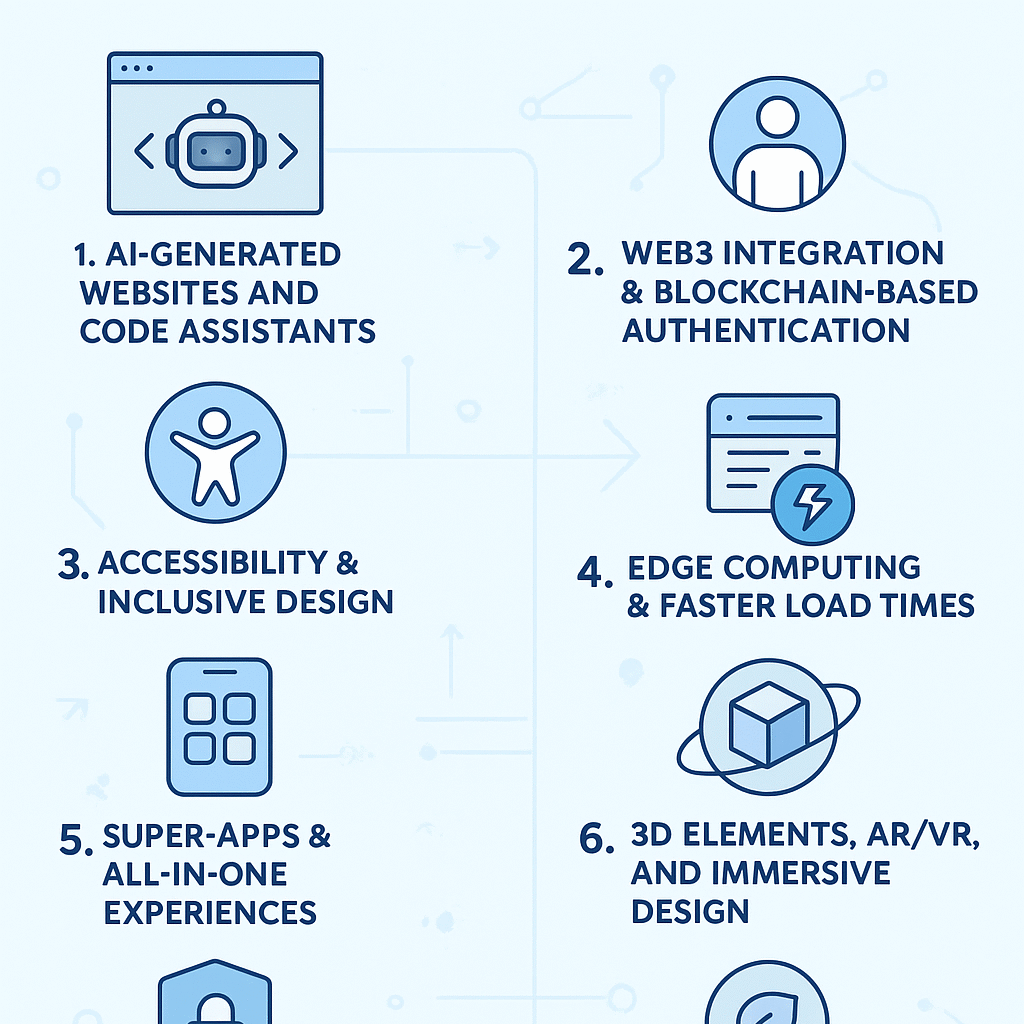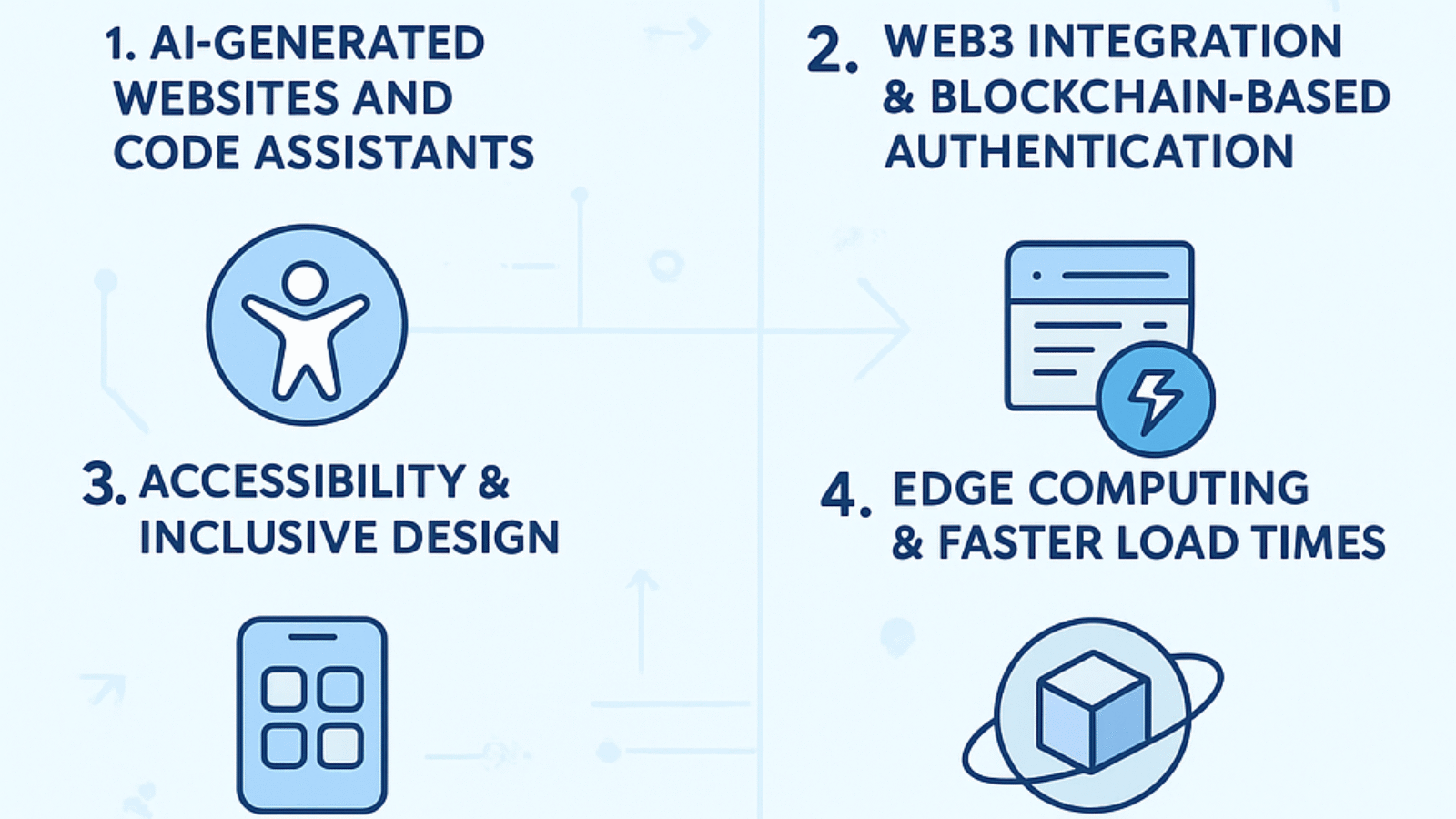Meta Description:
Discover the top web development trends in 2025. Learn how AI, Web3, and next-gen UX/UI are transforming websites and what your business must do to stay competitive.
The Future of Web Development in 2025: Trends Every Business Should Know
Web development is evolving faster than ever. What worked in 2020 may already be outdated today — and 2025 is bringing a new era of intelligent, user-centered, and highly automated digital experiences.
Businesses that fail to keep up risk losing relevance, traffic, and customers. But those who adopt the latest web development trends will gain a competitive edge, improve user experience, and future-proof their online presence.
In this in-depth guide, we’ll explore
the biggest web development trends of 2025, why they matter, and how your business can benefit from them.
1. AI-Generated Websites and Code Assistants
The rise of AI has completely transformed how developers build websites.
AI-powered tools such as
GitHub Copilot, ChatGPT, and Cursor IDE can now generate clean, production-ready code in seconds.
AI website builders like
Framer AI, Wix ADI, and Durable are letting businesses create professional websites without writing a single line of code — but human developers still play a crucial role in customization and optimization.
Why This Matters for Businesses:
- Reduces development time and costs
- Makes web development accessible to small businesses
- Speeds up prototyping and A/B testing
How to Leverage:
Partner with a web agency (like DiWebs Agency 😉) that uses AI-assisted workflows. This ensures you get
cost-effective, modern, and scalable websites.
2. Web3 Integration & Blockchain-Based Authentication
Web3 isn’t just about cryptocurrency — it’s about decentralization, security, and user control.
In 2025, we’re seeing more websites integrate
blockchain-based logins and
smart contract functionality.
Examples of Web3 Use Cases in Web Development:
- Decentralized logins: WalletConnect, MetaMask sign-in
- NFT-based memberships: Gated content for token holders
- Smart contract automation: Eliminates middlemen in payments
Why This Matters:
Users value privacy and control over their data. Offering Web3 logins can attract tech-savvy users and position your brand as forward-thinking.
3. Accessibility & Inclusive Design Becomes Mandatory
By 2025, accessibility is no longer optional. With lawsuits over inaccessible websites increasing globally, businesses must comply with
WCAG 2.2 standards.
Inclusive design goes beyond compliance — it makes your website usable by everyone, including people with disabilities.
Key Accessibility Trends:
- Voice-controlled navigation
- High-contrast and dark mode support
- AI-powered accessibility testing tools
- Inclusive language and imagery
Pro Tip: At DiWebs Agency, we perform
accessibility audits to ensure your site meets legal and ethical standards.
4. Edge Computing & Faster Load Times
Users expect websites to load in under 2 seconds — anything slower leads to massive bounce rates.
Edge computing is the new standard for speed. It processes requests closer to the user’s location rather than a central server, resulting in lightning-fast page loads.
Tools for 2025:
- Cloudflare Workers
- AWS Lambda@Edge
- Vercel Edge Functions
Why This Matters:
Website speed is directly tied to SEO rankings and conversions. A fast-loading site can boost your business revenue significantly.
5. Super-Apps & All-in-One Experiences
In 2025, users want
fewer apps, more functionality. This is why super-apps like
WeChat, Grab, and Gojek dominate in Asia — and the trend is spreading globally.
Websites are now becoming
mini-super apps, offering:
- Shopping
- Booking
- Chat
- Payments
- Social interaction
If your business can offer multiple touchpoints in one place, you’ll keep users engaged longer and increase conversions.
6. 3D Elements, AR/VR, and Immersive Design
Websites in 2025 are far from static. 3D product displays, augmented reality (AR) try-on features, and immersive VR tours are now standard for many industries.
Examples:
- Real estate websites with 360° property tours
- E-commerce stores with AR product previews
- Education platforms with gamified 3D lessons
7. Security-First Development
With cyberattacks on the rise, 2025 web development prioritizes security at every stage.
Key Measures:
- Zero-trust architecture
- Multi-factor authentication (MFA)
- AI-driven threat detection
- Regular penetration testing
Why This Matters:
A single breach can destroy customer trust. Secure websites are not just an IT priority but a business survival necessity.
8. Sustainability & Green Hosting
Eco-conscious consumers are driving businesses to adopt sustainable practices — including web hosting.
Green web development practices include:
- Carbon-neutral hosting providers
- Lightweight code to reduce energy consumption
- Dark mode (uses less screen power on OLED devices)
This not only helps the planet but also improves SEO since Google now considers sustainability as a ranking signal.
Conclusion: The Future of Your Website Starts Now
The future of web development is
fast, secure, inclusive, and intelligent. Businesses that embrace these trends will gain a competitive advantage, improve user experience, and stay ahead of their competitors.
If you want to prepare your business for the digital future,
DiWebs Agency can help. We specialize in building
AI-assisted, accessible, secure, and high-performance websites that are ready for 2025 and beyond.


Add a Comment